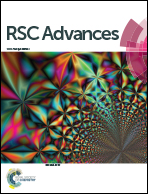Highly sensitive polyaniline-coated fiber gas sensors for real-time monitoring of ammonia gas†
Abstract
A single-yarn-based gas sensor has been made from conductive polyaniline coated on commercial yarns. This can detect ammonia gas concentration in an environment or a working area. Cotton, rayon and polyester are utilized as substrates using a dip-coating process. The conductive yarns show ohmic behavior with an electrical resistance of 15–31 kΩ cm−1. The conductive polyester yarn exhibits higher mechanical strength even after intensive chemical treatment. It also has the highest gas response of 57% of 50 ppm ammonia gas, the concentration at which health problems will occur. A linear gas response of the yarn sensor appears in a range of 5–25 ppm ammonia concentration. The polyester yarn sensor can be reused without any change in its sensing response. It can monitor gas levels continuously giving real-time results. By using a microcontroller as part of the circuitry, the gas detection results are transferred and updated wirelessly to a computer or to a smartphone. The textile-based gas sensor can be sewn directly onto the fabrics since it is made with the same fabric. This single-yarn-based gas sensor is suitable for mass production and is appropriate for sophisticated applications.



 Please wait while we load your content...
Please wait while we load your content...